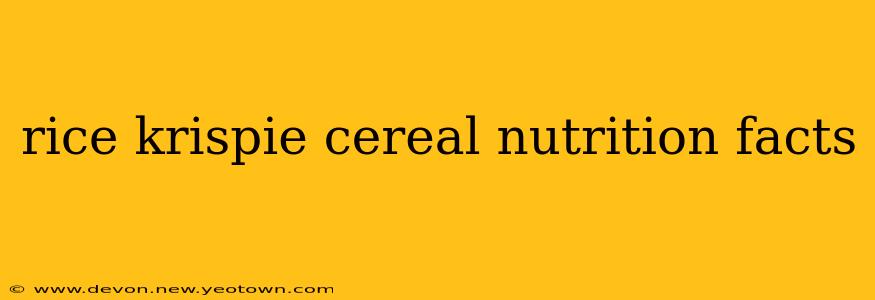Let's be honest, Rice Krispies hold a special place in many of our hearts. That snap, crackle, and pop sound is practically synonymous with childhood breakfasts. But beyond the nostalgic charm, what's the nutritional story behind this beloved cereal? This article delves into the nutritional facts of Rice Krispies, addressing common questions and providing a balanced perspective on its place in a healthy diet.
What are the nutritional facts of Rice Krispies?
The nutritional content of Rice Krispies can vary slightly depending on the serving size and specific product variations (like the addition of sugar or other ingredients). However, a typical serving (about 1 cup or 30g) of Kellogg's Rice Krispies generally contains the following:
- Calories: Roughly 110-120
- Fat: Very low, usually under 1 gram
- Saturated Fat: Minimal, often less than 0.5 grams
- Cholesterol: Zero
- Sodium: Moderate, usually around 200-250 mg
- Carbohydrates: Around 25 grams
- Fiber: Low, usually around 1-2 grams
- Sugars: Low, typically around 3-4 grams
- Protein: Low, around 2 grams
It's important to note that these are estimates, and it's always best to check the nutrition label on the specific box of Rice Krispies you purchase.
Are Rice Krispies healthy?
This is a question with no simple yes or no answer. Rice Krispies themselves are low in fat, cholesterol, and added sugars. They are also a good source of carbohydrates, providing quick energy. However, they are also relatively low in fiber and protein, making them less satiating than cereals with higher levels of these nutrients. The overall health impact of consuming Rice Krispies depends heavily on the context of your overall diet.
A small bowl as part of a balanced breakfast that includes fruit, yogurt, or nuts can be perfectly acceptable. However, relying on Rice Krispies as a primary breakfast food, particularly large portions, could lead to a diet lacking in essential nutrients.
How many calories are in a serving of Rice Krispies?
As mentioned before, a typical serving (1 cup or 30g) contains approximately 110-120 calories. However, this number can fluctuate based on factors like the specific product and portion size. Always refer to the nutrition label for the most accurate calorie count. It’s crucial to be mindful of portion sizes, as exceeding the recommended serving can significantly increase calorie intake.
What are the ingredients in Rice Krispies cereal?
The main ingredient in Rice Krispies is rice. Generally, the ingredient list is quite short, typically including rice, sugar, salt, and malt flavoring. Some variations may include added vitamins and minerals. Always check the specific ingredient list on your box to understand exactly what you're consuming. The simplicity of the ingredient list is a plus point for many consumers who prefer fewer additives.
How much sugar is in Rice Krispies cereal?
The sugar content in Rice Krispies is relatively low compared to many other breakfast cereals, typically around 3-4 grams per serving. However, it's vital to remember that this is added sugar, and while not excessively high in a single serving, regularly consuming foods with added sugar can contribute to unwanted health effects over time.
Are Rice Krispies good for weight loss?
While Rice Krispies aren't inherently bad for weight loss, they aren't the optimal choice for someone actively trying to shed pounds. The low fiber and protein content mean they don’t provide lasting satiety, which could lead to increased snacking later in the day. To support weight loss goals, prioritizing cereals high in fiber and protein is generally recommended.
In conclusion, Rice Krispies are a readily available and affordable cereal, but their place in a healthy diet should be considered carefully. Moderate consumption as part of a balanced and varied diet is acceptable, but relying on them as a primary breakfast option may lead to nutritional deficiencies. Always read nutrition labels and be mindful of portion sizes to make informed dietary choices.

